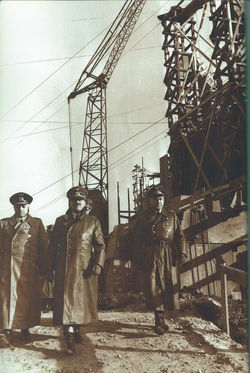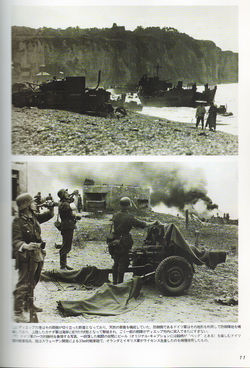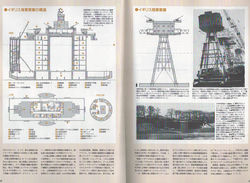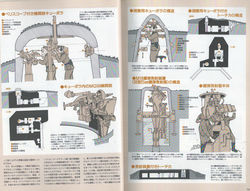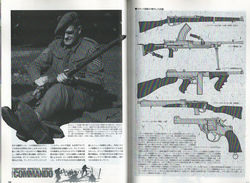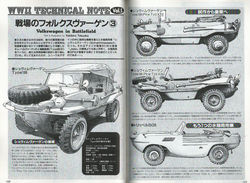GRAPHIC
ACTION 33 WW2 1942 DIEPPE ST. NAZAIRE CHANNEL DASH ATLANTIC WALL
VERY HEAVILY ILLUSTRATED
SOFTBOUND BOOK IN JAPANESE with ENGLISH LANGUAGE NOTES THROUGHOUT
DIEPPE OPERATION JUBILEE
(CANADIAN INFANTRY CALGARY REGIMENT, BRITISH COMMANDOS, US ARMY RANGERS)
Operation Jubilee or the Dieppe Raid (19 August 1942) was an unsuccessful
Allied amphibious attack on the German-occupied port of Dieppe in northern
France, during the Second World War. Over 6,050 infantry, predominantly
Canadian, supported by a regiment of tanks, were put ashore from a naval force
operating under protection of Royal Air Force (RAF) fighters.
CHANNEL DASH OPERATION CEREBUS
The Channel Dash (German: Unternehmen Zerberus, Operation Cerberus) was a
German naval operation during the Second World War. A Kriegsmarine (German
Navy) squadron comprising the two Scharnhorst-class battleships, the heavy
cruiser Prinz Eugen and their escorts was evacuated from Brest in Brittany to
German ports. Scharnhorst and Gneisenau had arrived in Brest on 22 March 1941
after the success of Operation Berlin in the Atlantic. More raids were planned
and the ships were refitted at Brest. The ships were a threat to Allied
trans-Atlantic convoys and RAF Bomber Command attacked them from 30 March 1941.
Gneisenau was hit on 6 April 1941 and Scharnhorst on 24 July 1941, after
dispersal to La Pallice. In late 1941, Adolf Hitler ordered the Oberkommando
der Marine (OKM; German Navy High Command) to plan an operation to return the
ships to German bases against a British invasion of Norway. The short route up
the English Channel was preferred to a detour around the British Isles for
surprise and air cover by the Luftwaffe and on 12 January 1942, Hitler gave orders
for the operation
ST. NAZAIRE RAID The St Nazaire
Raid or Operation Chariot was a British amphibious attack on the heavily
defended Normandie dry dock at St Nazaire in German-occupied France during the
Second World War. The operation was undertaken by the Royal Navy (RN) and
British Commandos under the auspices of Combined Operations Headquarters on 28
March 1942. St Nazaire was targeted because the loss of its dry dock would
force any large German warship in need of repairs, such as Tirpitz, sister ship
of Bismarck, to return to home waters by running the gauntlet of the Home Fleet
of the Royal Navy and other British forces, via the English Channel or the
North Sea. The obsolete destroyer HMS Campbeltown, accompanied by 18 smaller
craft, crossed the English Channel to the Atlantic coast of France and rammed
into the Normandie dry dock south gate. The ship had been packed with
delayed-action explosives, well hidden within a steel and concrete case, that
detonated later that day, putting the dock out of service until 1948.
1942 CROSS CHANNEL AIRWAR (RAF
vs LUFTWAFFE)
ADOLF GALLAND
FAIREY SWORDFISH TORPEDO BOMBER
STRINGBAG
THE FORTRESS OF THE ATLANTIC /
ATLANTIC WALL GUN FORTIFICATIONS
SEA FORTS
30.5cm SK L/50 By the end of
World War I, six guns in BSG mounts equipped Battery Friedrich August on the
island of Wangerooge. Three of these were transferred to Helgoland after 1935
when Hitler renounced the Treaty of Versailles which had demilitarized the
island. By 1938, they equipped Battery von Schröder and were manned by troops
of the Second Naval Artillery Battalion (II. Marine-Artillerie-Abteilung),
later 122nd Naval Artillery Battalion (122. Marine-Artillerie-Abteilung). After
the French were defeated in 1940 all three guns were transferred to Le
Trésorerie, near Boulogne-sur-Mer, France where they assumed their former name
of Battery Friedrich August. These guns were initially in open barbettes with
360° traverse, but these were later rebuilt into concrete casemates with
overhead cover.[16] that could elevate to 50 degrees and train 220 degrees in
either direction.
BRITISH SPECIAL FORCE COMMANDO
ROYAL NAVY X-CRAFT: The X class
was a World War II midget submarine class built for the Royal Navy during
1943–44. It was substantially larger than the original Chariot manned torpedo.
Known individually as X-Craft, the vessels were designed to be towed to their
intended area of operations by a full-size "mother" submarine –
usually one of the T class or S class – with a passage crew on board, the
operational crew being transferred from the towing submarine to the X-Craft by
dinghy when the operational area was reached, and the passage crew returning
with the dinghy to the towing submarine. Once the attack was over, the X-Craft
would rendezvous with the towing submarine and then be towed home. Range was
limited primarily by the endurance and determination of their crews, but was
thought to be up to 14 days in the craft or 1,000 nmi (1,900 km), after
suitable training. Actual range of the X-Craft itself was 600 nmi (1,100 km)
surfaced and 80 nmi (150 km) at 2 knots (3.7 km/h) submerged.
WWII TECHNICAL NOTES: GERMAN
VOLKSWAGEN TYPE 62 & TYPE 166: The Volkswagen Type 82 Kübelwagen or simply
Kübel, contractions of the original German word Kübelsitzwagen (translated:
'bucket-seat car' — but when the contractions are translated literally a
back-formation of 'bucket' or 'tub'-car results), is a military light utility
vehicle designed by Ferdinand Porsche and built by Volkswagen during World War
II for use by the Nazi German military (both Wehrmacht and Waffen-SS). Based
heavily on the Volkswagen Beetle, it was prototyped and first deployed in
Poland as the Type 62, but following improvements entered full-scale production
as the Type 82. Several derivative models, such as the Kommandeurswagen, were
also built in hundreds, or in dozens.
The four-wheel drivetrain that was prototyped in the rejected Type 86
version went into mass production in the Schwimmwagen. The Type 86 performed
better in comparative testing, but the additional costs of the more complex
four-wheel drivetrain (both financial, as well as making the light car heavier
and thirstier) did not outweigh the benefits from the German viewpoint. The
Kübelwagen was intended to be able to be manhandled by its crew when they got
stuck. Easily seating four men, the 725 kg (1,600 lb) empty weight Kübel was
easier to lift than the 300 kg (660 lb) heavier jeep. The rear bench would seat
three in a pinch, for a total of five inside.
The Volkswagen Schwimmwagen (literally "swimming car") is a
light four-wheel drive amphibious car, used extensively by German ground forces
during the Second World War. With over 15,000 units built, the Schwimmwagen is
the most-produced amphibious car in history. Prototyped as the Type 128, it
entered full-scale production as the Type 166 in 1941 for the Wehrmacht.




